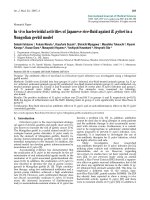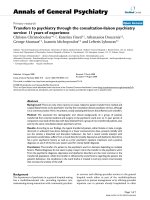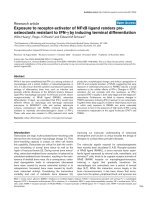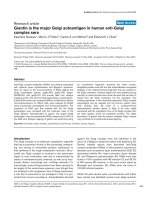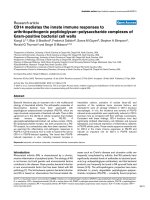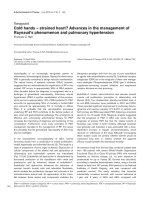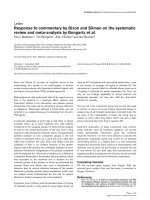Báo cáo y học: " Journey to the heart of macrophages: the delicate relationship between HIV-1 and a multifaceted cell type" ppt
Bạn đang xem bản rút gọn của tài liệu. Xem và tải ngay bản đầy đủ của tài liệu tại đây (184.78 KB, 2 trang )
COM M E N T AR Y Open Access
Journey to the heart of macrophages: the
delicate relationship between HIV-1 and a
multifaceted cell type
Andrea Cimarelli
1,2,3
Abstract
Cells of the monocyte-macrophage lineage play multiple roles during the infection of primate lentiviruses serving
as reservoirs for viral production or as vectors for viral spread to other cells and tissues. The human immu nodefi-
ciency type I virus is not only capable of establishing such complex and dynamic relations with this cell type, but
is also able to modulate their physiology and behavior, thus shaping ensuing cellular immune responses. In this
issue of Retrovirology, a series of reviews explores the multiple manner s in which the virus and cells belonging to
the monocyte-macrophage lineage interact and affect each other.
Introduction
This issue of Retrovirology presents a series of reviews
centered on the complex relationship established
between monocytes/macrophages and the human immu-
nodeficiency type I virus (HIV-1). This cell type plays
multiple and important roles during viral replication
and pathogenesis serving as a haven for the multiplica-
tion of the v irus, as a vehicle for its spread into pr ivi-
leged sites, as a cel l type to take over and modify host
immune responses. The reviews presented here deal
extensively with all these issues, leading the reader to
appreciate the prominent role of macrophages during
HIV-1 induced pathogenesis.
Discussion
Macrophages are resident cells that differentiate in tis-
sues upon migration of circulating blood monocytes.
Migration can occur through the blood brain barrier
accounting for the passage of HIV-1 into the central
nerv ous system or to sites of infection. Tissue residency
is accompanied with the differentiation of monocytes in
macrophages, a differentiation that is heavily dependent
on the environment in which the cells find themselves.
There, as prof essional antigen presenting cells (APCs),
macrophages establish numerous contacts with T cells
and participate with cytokin e secretion to mount appro-
priate immune responses.
It seems clear that monocytes and by extension
macrophages represent a heterogeneous cell population
that includes cells of different functionalities. At least
two major monocyte populations exist that are charac-
terized by the surface expression of the CD14 and CD16
markers (either CD14
+
CD16
-
or CD14
+
CD16
+
), and evi-
dence for a differential behavior of these two c ell popu-
lations with respect to HIV-1 clearly exist [1]. To add to
their heterogeneity, differentiation of monocytes into
macrophages can be accomplished following a number
of stimuli. Monocytes do not simply differentiate into a
single type of macrophage, but do so via concomitant
polarization, that is through the specific differentiation
into macrophages of specific functionalities. Schemati-
cally, this polarization can lead to macrophages with
pro- or anti-inflammatory and tissue repair properties
defined as M1 or M2 macrophages by analogy with the
Th1 and Th2 nomenclature of he lper T cells [2], but it
is likely that this represents a simplification of a more
plastic polarization system.
In this cell type, or rather in these cells which are so
similar yet so different, HIV-1 replicates. HIV-1 is not
alone among lentiviruses to infect monocytes/macro-
phages. The Visna/CAEV and the equine infectious ane-
mia (EIAV) viruses display an exquisite, even more
restricted, preference for this cell type [3,4], possibly
Correspondence:
1
LaboRetro, Department of Human Virology, Ecole Normale Supérieure de
Lyon, Lyon, France
Cimarelli Retrovirology 2010, 7:28
/>© 2010 Cimarelli; lice nsee BioMed Central Ltd. This is an Open Access article distributed un der the terms of the Creative Commons
Attribu tion License ( /by/2.0), which p ermits unrestricted use, distribution, and reproduction in
any medium, provided the original work is properly cited.
underlying the impor tant role that myeloid cells have in
lentivirus infection.
Despite the fact that circulating monocytes are rather
resistant to HIV-1 infection, these cells bear HIV-1
in vivo and piggyback the virus into tissues and through
the blood brain barrier into the central nervous system
[5,6]. With their differentiation into macrophages, and
according to the stimulation received, macrophages
become permissive to HIV-1, and albeit remaining more
restrictive to the virus than other cell types, become
overtly infected. The virus takes hold of these cells and
uses them to spread to neighboring T cells, to support a
low persistent level of virus production, as well as to
influence the cytokines secreted by these cells.
If some of these properties can be shared with T cells,
macrophages display peculiar properties with which the
virus is confronted, and the reviews presented here
clearly depict these differences. Two reviews, from
Ayinde and from Benaroch and colleagues explore the
specificities of macrophages with respect to different
aspects of the viral life cycle [7,8]. The first details the
latest findings on the role t hat the non-structural viral
proteins Vpr and Vpx (the first conserved among all pri-
mate lentiviruses; the second coded almost exclusively
by members of the HIV-2/SIV
SM
lineage) play during
the early phases of infection of macrophages, while the
second provides a thorough description of the process
of virion particle production (i.e. virion assembly). A
third review by Bergama schi and Pancino more globally
outlines the overall blocks that hinder the life of HIV-1
inside monocytes and macrophages [9].
The molecular mechanisms with which a viral reser-
voir is established in macrophages is reviewed by Le
Douce and colleagues [10], while the mechanism with
which monocytes allow entry of HIV-1 into the central
nervous system, where the virus c auses a series of neu-
rological disorders collectively named HIV encephalitis
(HIVE) is described by the accompan ying review of
Gras and Kaul [11]. Finally, the interplay between
macrophage polarization and the effect that different
viral proteins exert on the activation status of macro-
phages are described in two reviews by Herbein and
Varin, and Herbein and colleagues [12,13].
Conclusions
The reviews presented in this issue of Retrovirology
explore a number of interesting issues and collectively
concur in depicting a comprehensive overview of the
delicate relationship establ ished between macrophages
and HIV-1.
Acknowledgements
AC acknowledges the CNRS, INSERM, ANRS and Sidaction for support.
Author details
1
LaboRetro, Department of Human Virology, Ecole Normale Supérieure de
Lyon, Lyon, France.
2
INSERM, U758, Lyon, France.
3
University of Lyon 1,
IFR128 BioSciences Lyon-Gerland, Lyon-Biopole, Lyon, France.
Competing interests
The author declares that they have no competing interests.
Received: 4 January 2010 Accepted: 7 April 2010 Published: 7 April 2010
References
1. Ancuta P, Kunstman KJ, Autissier P, Zaman T, Stone D, Wolinsky SM,
Gabuzda D: CD16+ monocytes exposed to HIV promote highly efficient
viral replication upon differentiation into macrophages and interaction
with T cells. Virology 2006, 344:267-276.
2. Mantovani A, Sica A, Sozzani S, Allavena P, Vecchi A, Locati M: The
chemokine system in diverse forms of macrophage activation and
polarization. Trends Immunol 2004, 25:677-686.
3. Peluso R, Haase A, Stowring L, Edwards M, Ventura P: A Trojan Horse
mechanism for the spread of visna virus in monocytes. Virology 1985,
147:231-236.
4. Maury W: Monocyte maturation controls expression of equine infectious
anemia virus. J Virol 1994, 68:6270-6279.
5. Kilareski EM, Shah S, Nonnemacher MR, Wigdahl B: Regulation of HIV-1
transcription in cells of the monocyte-macrophage lineage. Retrovirology
2009, 6:118.
6. Coleman CM, Wu L: HIV interactions with monocytes and dendritic cells:
viral latency and reservoirs. Retrovirology 2009, 6:51.
7. Ayinde D, Maudet C, Transy C, Margottin-Goguet F: Limelight on two HIV/
SIV accessory proteins in macrophage infection: is Vpx overshadowing
Vpr? Retrovirology 2010, 7:35.
8. Benaroch P, Billard E, Gaudin R, Schindler M, Jouve M: HIV-1 assembly in
macrophages. Retrovirology 2010, 7:29.
9. Bergamaschi A, Pancino G: Host hindrance to HIV-1 replication in
monocytes and macrophages. Retrovirology 2010, 7:31.
10. Le Douce V, Herbein G, Rohr O, Schwartz C: Molecular mechanisms of
HIV-1 persistence in the monocyte- macrophage lineage. Retrovirology
2010, 7:32.
11. Gras G, Kaul M: Molecular mechanisms of neuroinvasion by monocytes-
macrophages in HIV-1 infection. Retrovirology 2010, 7:30.
12. Herbein G, Gras G, Aziz Khan K, Abbas W: Macrophage signalling in HIV-1
infection. Retrovirology 2010, 7:34.
13. Herbein G, Varin A: The macrophage in HIV-1 infection: from activation
to deactivation? Retrovirology 2010, 7:33.
doi:10.1186/1742-4690-7-28
Cite this article as: Cimarelli: Journey to the heart of macrophages: the
delicate relationship between HIV-1 and a multifaceted cell type.
Retrovirology 2010 7:28.
Submit your next manuscript to BioMed Central
and take full advantage of:
• Convenient online submission
• Thorough peer review
• No space constraints or color figure charges
• Immediate publication on acceptance
• Inclusion in PubMed, CAS, Scopus and Google Scholar
• Research which is freely available for redistribution
Submit your manuscript at
www.biomedcentral.com/submit
Cimarelli Retrovirology 2010, 7:28
/>Page 2 of 2

